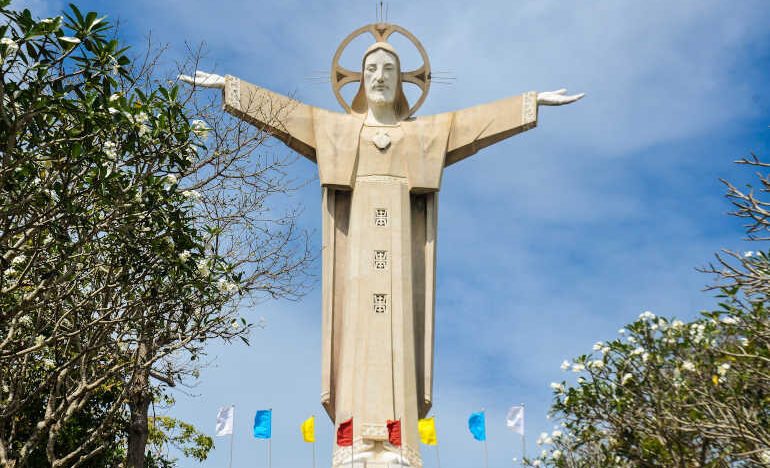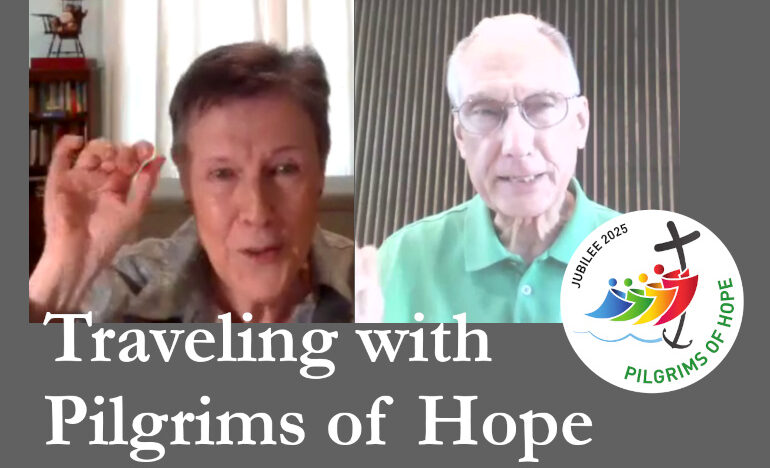Yearning for Peace: Teachings of Jesus and the Buddha

By Kathy Keary
Part 1
Each year the Catholic Church marks January 1 as the World Day of Peace, a tradition began in 1968 when Pope Paul VI declared: “The world must be educated to love Peace, to build it up and defend it.”
In his Invocation for Peace, Pope Francis petitions the divine to “instill in our hearts the courage to take concrete steps to achieve peace” and “to see everyone who crosses our path as our brother or sister.” He prays that “the words ‘division,’ ‘hatred,’ and ‘war’ be banished from the heart of every man and woman.”
Note: Never miss an article published on the Renewal Center website: Sign up to receive our newsletters
The popes are not alone in their calls for peace; the theme is prevalent in diverse faith traditions embraced by God’s people scattered throughout the globe. In his book, Living Buddha, Living Christ, Thich Nhat Hanh, a highly regarded Vietnamese Buddhist monk, quotes Professor Hans Kung, a Swiss Catholic priest: “Until there is peace between religions, there can be no peace in the world.” Hanh instructs: “Learn and practice nonattachment from views in order to be open to receive others’ viewpoints. To me, this is the most essential practice of peace.”
As we begin a new year in a divided world that thirsts for peace, our Contemplative Living Series will turn its focus to the many ways in which two contemplatives, Jesus Christ and the Buddha, proclaimed similar messages that continue to stand at the heart of Christianity and Buddhism.
Jack Kornfield, a well-respected psychologist, meditation teacher, and founder of two of the largest Buddhist centers and communities in the United States opines: “When we listen deeply to their [Jesus and Buddha] words, we find that in many ways, they speak with one heart … Jesus and Buddha say to us today, ‘Follow me.’ Do we dare?”
Marcus Borg, a renowned American Anglican New Testament scholar states in his book, Jesus and Buddha: The Parallel Sayings:
Jesus and Buddha are the two most remarkable religious figures who have ever lived. Moreover, there are striking similarities between them. I have sometimes said that if the Buddha and Jesus were to meet, neither would try to convert the other — not because they would regard such an effort as hopeless, but because they would recognize one another.
Borg points out several similarities between Jesus and Buddha.
- Their ethical teaching is remarkably similar. This includes not only specific teachings such as love of neighbor but also lessons in the area of general principles such as the primacy of compassion.
- Compassion is the main characteristic of a bodhisattva, a Buddhist saint. Jesus summarized the life that would result from following his way by saying” “Be compassionate as God is compassionate.”
- Both experienced life-changing transformation around the age of 30.
- Both began spiritual movements within their own religious traditions: Judaism in the case of Jesus and Hinduism in the case of Buddha.
- There are similarities in the religious traditions that blossomed out of their teachings.
- The magnitude of their impact upon their followers was immense. Both were exalted being perceived as more than human; however, neither affirmed this position.
- Both were wisdom teachers. Borg elaborates: “Wisdom is not just about moral behavior, but about the ‘center,’ the place from which moral perception and moral behavior flow.”
- Both challenged the status quo contradicting customary ways of seeing and being as a path of transformation. In the words of Borg: “Both were teachers of the way less traveled.”
- The Buddha called people away from grasping, the cause of suffering, to letting go of grasping, the path of freedom from suffering. Similarly, Jesus preached dying to an old way of being to put on a new way of being.
Borg also points out key difference between Jesus and the Buddha.
- The Buddha lived in India about 500 years before Jesus was born in Israel.
- Unlike Jesus, social and political passion is absent in Buddha’s teaching. Buddha did not challenge the prevalent system of domination pointing to a different social vision as Jesus did.
- Most likely because Jesus railed against the social system, his public life was drawn to an end in one to four years. Buddha’s public life spanned a period of 50 years.
- Jesus was born into the peasant class while Buddha came from the wealthy ruling class.
- In contrast to the Buddha, Jesus’ role models, were the Jewish prophets who vehemently protested against social inequity as evidenced in the Old Testament (Borg 10).
There have been several theories proposed to explain the similarities in the teachings of these two contemplatives. Borg points out: “Both Jesus and the Buddha offered a similar diagnosis of the typical human condition: blindness, anxiety, grasping, self-preoccupation. In both cases, the prescription for cure is similar: ‘seeing,’ ‘letting go,’ ‘dying.’” These same human conditions exist today as do these remedies.
New articles in this series are posted to the website every Monday. The full series can be found here: An Invitation to Something New: The Contemplative Life. On Thursday’s we’ll send an email to remind you of the articles.
Read Kathy Keary’s article “Maintaining the Contemplative Life in a Divided World.”
I agree with Borg who opines that the similarities between Jesus and the Buddha rests in their personal experience of the sacred. Both men were affected by a life-altering transformation that directed their way of being in the world. Their way of seeing and teaching flowed from their personal enlightenment. Both men embodied the contemplative life.
In future articles, we will explore the specific teachings of Jesus and the Buddha with an emphasis on the similarities in the words they professed. It is our hope that in doing so we will all grow in our understanding of two distinct faiths and that this understanding sets us on a path leading to acceptance, harmony and peace among the people of God.
References:
- Borg, Marcus. Jesus and Buddha: The Parallel Sayings. Berkley, California: Ulysses Press, 2004.
- Hanh, Thich Nhat. Living Buddha, living Christ. New York, New York: Riverhead Books, 2007.
Image by bruce lam from Pixabay. “Christ of Vung Tau” in Vũng Tàu, Vietnam. Completed in 1993, the concrete monument is more than 100 feet tall with an impressive combined arm span of 120 feet. Perched atop Mount Nho, the colossal Christ is further elevated by a 15-foot high platform. The stone son of God is designed in an angular style reminiscent of the art deco movement, complete with a sharply abstract halo. Visitors can ascend a staircase that rises up the body with viewing windows to the outside inset along the way. Learn more.
[Kathy Keary, a Precious Blood Companion and spiritual director, holds a master’s degree in theological studies and is a graduate of the Atchison Benedictine’s Sophia Center’s Souljourners Program, an intense study of spirituality and spiritual direction. Kathy believes that the divine is present and active in all of life and encourages others to be awakened to the God in all including the divine within. She enjoys accompanying others on their journey to wholeness discovering the person they were created to be.]
We’d Like to Hear From You!
We’d like to know what you think about our The Contemplative Life Series. Send us a comment using the form below. Do you have a suggestion? Is there something you want to learn more about? Send us a note.
Related

Pilgrims of Hope, Episode 6: Walking with Cancer Survivors
Hosted by Fr. Ron Will, C.PP.S.
We are talking with people who find hope amid difficult circumstances or bring hope to others. In this episode, Kathy Keary talks about how centering prayer, journaling and other spiritual practices helped her cope with two life threatening health issues.

The Rollercoaster Torture
An Assembling God’s Puzzle video
By Fr. Garry Richmeier, C.PP.S.
Life is full of ups and downs, like a roller coaster, and that fact is a piece of life’s puzzle that we must deal with. Depending on how we deal with it, it can be torture, or it can be simply another difficult aspect of life to be navigated. How do we avoid the torture?
Categories
Assembling God's Puzzle Coffee with Padre Cooking & Spirituality Encounters of the 4th Kind Family Matters Reflections on the Eucharsitic Prayers Spiritual Resources Taize Prayers The Contemplative Life Traveling with Pilgrims of Hope Uncategorized Videos Week of Prayer for Uhristian Unity When you need a little help
